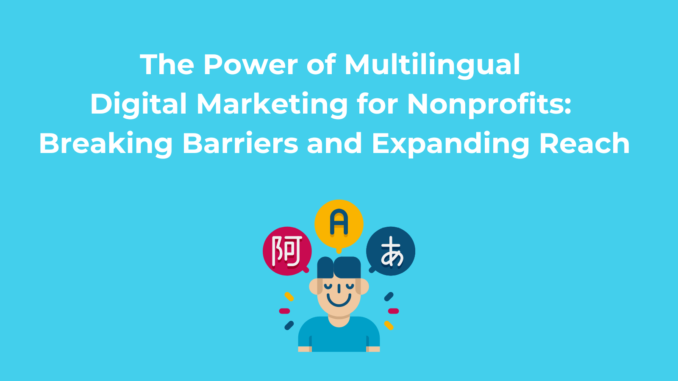
The Power of Multilingual Digital Marketing for Nonprofits: Breaking Barriers and Expanding Reach
Unlock nonprofit potential with multilingual digital marketing. Break barriers, reach global audiences, and amplify your impact.

The digital marketing landscape for nonprofit organizations has evolved rapidly over the past few years. The ability to reach and engage a global audience has become essential, given the rise in internet users worldwide, now estimated to be . The advent of the digital age offers a unique opportunity to nonprofits, enabling them to communicate their mission across different geographical and linguistic boundaries.
Nonprofits must speak their language to better resonate with diverse audiences. The global nature of the internet means that nonprofits’ messages have the potential to reach audiences who speak different languages. With readily available, creating multilingual digital marketing has become much faster and can significantly broaden an organization’s outreach and impact.
Translation and localization strategies can empower nonprofits to break language barriers and expand their reach through effective communication, leading to an increased support base and stronger relationships with donors, volunteers, and the communities they serve.
Understanding the Impact of Language Barriers

Nonprofits face unique challenges in communicating their messages to audiences who speak different languages. Language barriers can lead to misunderstanding, lack of engagement, and missed opportunities.
Missed Opportunities and Limitations Caused by Language Barriers
Language barriers can indeed create numerous missed opportunities and limitations for nonprofits. Here are a few key ones:
Multilingual digital marketing can bridge these gaps and help nonprofits reach audiences they would otherwise miss. It enables nonprofits to communicate effectively across languages, fostering understanding, and creating connections.
Leveraging Translation and Localization Strategies

Translation and localization are two key strategies that nonprofits can leverage in their digital marketing efforts. While translation is the process of converting text from one language to another, localization adapts content to a specific locale or market.
Key Benefits of Using Translation and Localization for Nonprofits
Nonprofits with translation and localization strategies can create content that resonates with different audiences, enhancing engagement and reach. These strategies enable nonprofits to build relationships with diverse communities, fostering mutual understanding and respect.
- Greater Audience Engagement: By communicating in the language of the audience, nonprofits can better engage donors, volunteers, and beneficiaries.
- Improved Visibility: Localizing website content helps improve search engine rankings in different languages, thereby enhancing the visibility of nonprofits.
- Expanded Donor Base: By reaching out to donors in their own language, nonprofits can expand their donor base.
- Increased Volunteer Participation: Multilingual communication can increase volunteer participation from diverse linguistic backgrounds.
- Effective Cross-Cultural Communication: Translation and localization foster better cross-cultural understanding, which can enhance the credibility and effectiveness of a nonprofit.
- Wider Impact of Services: Nonprofits can widen the impact of their services by breaking down language barriers, thereby reaching a larger beneficiary base. There are several articles on how language support can significantly improve the uptake and effectiveness of services, especially in communities with low English proficiency.
One successful example of a nonprofit leveraging multilingual digital marketing is . The organization has a presence in over 120 countries and offers its website in various languages, facilitating engagement with diverse communities and maximizing the impact of its work.
Tailoring Digital Marketing Messages for Multilingual Audiences

For effective multilingual digital marketing, it’s not enough to just translate the words; the message must be adapted to each audience’s cultural nuances and local preferences.
Cultural nuances, societal norms, and local customs can significantly influence how a message is received. Localization enables nonprofits to adapt their messages accordingly, enhancing their appeal and relevance.
Language plays a pivotal role in evoking emotions and building connections. By communicating in the audience’s native language, nonprofits can build trust and rapport, fostering stronger relationships.
Maintaining a consistent brand voice across languages can be challenging. Strategies such as developing multilingual style guides and using professional translators who understand the brand’s tone and voice can help ensure consistency.
Choosing the Right Translation and Localization Techniques
There are various translation methods, such as machine translation, using professional translators, or crowdsourcing. Each method has its benefits and drawbacks, and the choice depends on factors such as budget, time, and quality requirements.
Quality control is crucial in translations to ensure accuracy and prevent miscommunication. Using professional translators or translation services that offer quality control can ensure accuracy.
Localization goes beyond translating text. It includes adapting visuals, currencies, measurements, and other elements to the local context, enhancing the audience’s connection with the content.
Choosing the Right Translation and Localization Techniques
There are various translation methods, such as machine translation, using professional translators, or crowdsourcing. Each method has its benefits and drawbacks, and the choice depends on factors such as budget, time, and quality requirements.
Quality control is crucial in translations to ensure accuracy and prevent miscommunication. Using professional translators or translation services that offer quality control can ensure accuracy.
Localization goes beyond translating text. It includes adapting visuals, currencies, measurements, and other elements to the local context, enhancing the audience’s connection with the content.
Building a Multilingual Online Presence

Building a multilingual online presence involves translating website content, localizing social media profiles, and implementing multilingual email marketing and online advertising campaigns.
Translating website content not only makes it accessible to diverse audiences but also improves search engine optimization (SEO), increasing visibility in different regions. Tools like Google’s can help in this process.
Localizing social media profiles involves more than just translating content. It also requires understanding the social media habits of the target audience and engaging with them in ways that resonate with their cultural context.
Implementing multilingual email marketing and online advertising campaigns allows nonprofits to communicate with their audiences in their preferred languages, enhancing engagement and response rates.
Measuring the Impact and Success of Multilingual Digital Marketing
Evaluating the effectiveness of multilingual digital marketing involves identifying key performance indicators (KPIs), analyzing data and feedback, and making data-driven adjustments for continuous growth.
Identifying KPIs such as website traffic, social media engagement, and email response rates can provide insights into the effectiveness of multilingual digital marketing.
Analyzing data and feedback can help nonprofits understand how their multilingual content is performing and where adjustments may be needed.
Based on the insights gained from data analysis, nonprofits can make data-driven adjustments to their multilingual digital marketing strategies, driving continuous growth and improved outcomes.
Overcoming Challenges and Roadblocks
Implementing multilingual digital marketing can present challenges such as resource constraints and linguistic complexities. However, these challenges can be overcome with careful planning and the right strategies. Here are a few common challenges and how they can be addressed:
1. Resource Constraints: Nonprofits often operate under tight budgets, making allocating resources for translation services difficult.
Leverage cost-effective technologies like machine translation tools. While they may not be as accurate as human translators, they can still provide a good starting point. Google Translate and DeepL are two popular options.
However, you will still need to work with specialized from translation services to ensure that translations are accurate and relatable to your target audience. You can collaborate with translators with experience working with nonprofits and marketing to ensure the message is conveyed correctly.
2. Partnerships: Finding the right partners to collaborate with on language expertise can be difficult. Look for partnerships with universities, language institutes, or other nonprofits. Engaging bilingual volunteers or interns can also be a cost-effective solution. The can be a good starting point to find translation partners.
Effective resource and budget management are crucial for successful multilingual digital marketing. Using tools that automate translations, leveraging volunteers who speak different languages, and prioritizing key markets can help manage resources effectively.
Partnerships and collaborations can provide shared language expertise, helping nonprofits overcome language barriers. Collaborations with other organizations that have established multilingual resources can be particularly beneficial in this regard.
Conclusion
Multilingual digital marketing holds significant potential for nonprofits. By breaking language barriers, these organizations can effectively communicate their mission to a larger audience and expand their reach.
The power of multilingual digital marketing lies in its ability to make nonprofits more accessible, inclusive, and relevant to diverse audiences. It allows organizations to tap into new donor bases, engage with a broader community, and amplify their impact.
Embracing translation and localization as strategic advantages, nonprofits can harness the power of digital marketing in today’s interconnected world. By doing so, they not only ensure their messages resonate with diverse audiences but also take a significant step towards fulfilling their mission on a global scale.
Join our Digital Marketing Community & Courses and Achieve your Goals
We all have blind spots. A community, advisors, and step-by-step courses can help you see what you’re missing and grow faster than ever before.
The post The Power of Multilingual Digital Marketing for Nonprofits: Breaking Barriers and Expanding Reach appeared first on GlobalOwls.

Leave a Reply